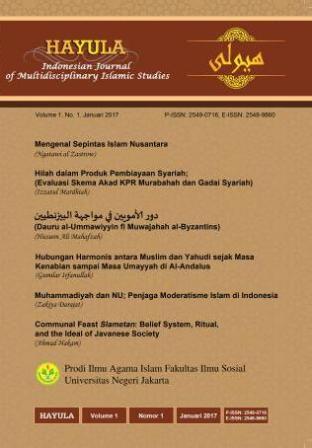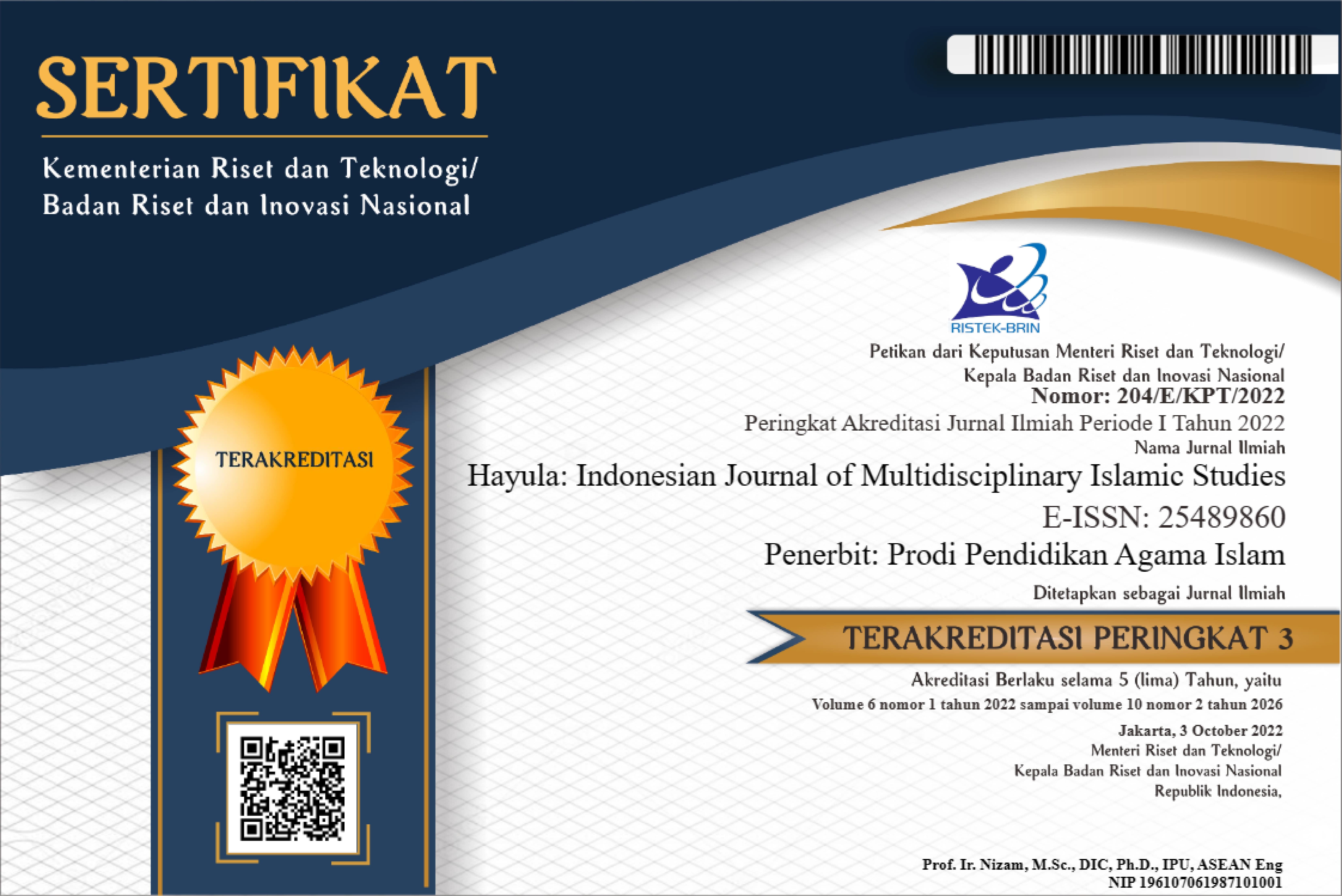Kesepadanan Terjemahan Polisemi: Penelitian Analisis Konten pada Terjemahan Surat al-Baqarah Kementerian Agama
DOI:
https://doi.org/10.21009/hayula.001.2.01Keywords:
Translation of Al-Quran , translation equivalence , polysemyAbstract
This research aims to assess the equivalence of polysemy translation from Arabic into Indonesian in al-Baqarah from the Indonesian Ministry of Religious Affairs translation version. The research was conducted from the results of al-Baqa>rah translation which is published by Ministry of Religious Affairs. This Reseach uses qulaitative method with content analysis. Primary data are derived from translation texts which is containing polysemy in the al-Baqa>rah translation of the ministry of religious affairs version, especially the result of translation toward verses which is containing polycemy. Secondary data are obtained from an authoritative interpretation books such as Tafsir Jami‘ al-Bayan, Tafsir al-Fahru al-Razi, Tafsir al-Ruh al-Ma‘ani and Tafsir al-Maraghi. The researche found that (1) there are 12 words of polycemy in Al-Baqarah which consisted of fi’il (verba), isim (nomina) and huruf (particles). (2). There are four procedures in the translations which are conducted by ministry of religious affairs such as transposition, modulation, subastraction and addition (3) the translations of polysemy in the al-Baqarah from ministry of religious affairs version have the type of equivalent translation, but the problem is there is the tendency of translators who often chose the prototypical meaning as option whereas there are words which should not be right if using that meaning and must refer to the secondary meaning.
References
Lukman, F. (2016, Juli-Desember). Studi Kritis atas Teori terjemah al-Quran dalam Ulum al-Qur’an. Jurnal al-A’raf, Vol. XIII (2), 172.
Manzur, I. (2000). Lisa>n al-’Arab (Vol. Vol. V).
Agama, D. (2009). Al-Quran dan Tafsirnya. Jakarta: Departemen Agama RI.
al-Alu>si, J. B. (2008). Ah}ka>m al-Tarjamah al-Quran. Beirut:: Dar Ibnu Hazm.
al-Alusi, S. M. (2000). al-Ruh al-Ma‘a>ni (Vol. I). Beirut: Darul Kutub.
al-Maraghi, M. (2004). Tafsi>r al-Mara>ghi> (Vol. II). Beirut: Dar al-Kita>b al-Ilmiah.
al-Munjid, M. N. (2007). Mustarak al-Lafdzy fi Diraasat al-Muhadditsin. Cairo: Darul Ma’arif.
al-Munjid, M. N. (2008). Al-Ishtirak al-Lafzi fi al-Qur’a>n al-Kari>m. Beirut: Dar Al Fikr.
al-Razi. (n.d.). Tafsir al-Fahru al-Ra>zi (Vol. III).
al-T}abari>. (2004). Ja>mi‘ al-Baya>n fi Ta’wil al-Qur’a>n (Vol. Vol.I).
al-T}abari>. (2004). Jami al-Baya>n fi Ta’wil al-Qur’a>n (Vol. V).
al-T}abari>, I. J. (2004). Ja>mi‘ al-Baya>n fi Ta’wi>l al-Qur’a>n (Vol. II). Beirut: Dar al-Fikr.
al-T}abari>, I. J. (n.d.). Ja>mi’ al-Baya>n fi Ta’wi>l al-Qur’a>n (Vol. Vol. III.).
Al-Wasthy, S. D. (1983). Tarjamah al-‘Alamiyyah. Baghdad: Jamiah Baghdad.
A-Shuyu>t}i, J. M. (2004). Al-Itqa>n fi Ulu>mil al-Qur'a>n. Beirut: Da>rul Fikr.
Burdah, I. (2004). Menjadi Penerjemah: Metode dan Wawasan Menerjemah Teks Arab. Jogjakarta: Tiara Wacana.
Catford, J. (1969). Linguistics Theory of Translation. Oxford: Oxford Uniersity Press.
Daud, S. a. (1983). Tarjamah al-'Alamiyyah. Baghdad: Jamiah Baghdad.
Emzir. (2010). Metodologi Penelitian Kulaitatif Analisis Data. Jakarta: Rajawali Press.
Fathoni, A. (2006). Penelitian Tekhnik Penyusunan Skripsi. Jakarta: PT Asdi Mahasatya.
Ghazanfar, S. (2003). Scholastic Economis and Arab Scholars: The "Great Gap' Thesis Reconsidered. In S. Ghazanfar, Medieval Islamic Economic Thought (p. 6). London: RoutledgeCurzon.
Hadiyanto, A. (n.d.). Tarjamah al-Qur'a>n li al Wuza>rah al- Diniyyah Indonesia,. p. 3.
Hanafi, M. (2011). Problematika Penerjamahan al-Quran dalam Jurnal Shuhuf. p. 181.
Buletin Khazanah Keagamaan (Vol. I). (2012 ). (Huriyudin, Trans.) Jakarta: Kementrian Agama.
J. Evans, A. (2007). Glossary of Cognitive Linguistics. Eidenburgh: Eidenburgh Uniersity Press.
Kasim, S. (2004). Pramasastra Arab. Jakarta: Prakarsa Belia.
Koentjaraningrat. (1979). “Metode Penggunaan Bahan Dokumen. In Sartono Kartodirdjo, Metode-Metode Penelitian (p. 65). Jakarta.
Krippendof, K. (2014). Content Analysis: An Introduction to its Metodology. New Delhi: Sage Publication.
Machalli, R. (2005). Pedoman Bagi Penerjemah. p. 5.
Manfredi, M. (2004). Translating Text and Contexs: Translation Studies and Systemic Funcional Linguistics. Bologna: Bologna University.
Manzur, I. (2000). Lisa>n al-‘Arab (Vol. Vol. I). Cairo: Dar al-Ma‘a>rif.
Manzur, I. (2000). Lisa>n al-’Arab (Vol. Vol. IV). Cairo: Dar al-Ma‘a>rif.
Manzur, I. (2000). Lisa>n al-’Arab (Vol. Vol. III). Cairo: Dar al-Ma‘a>rif.
Mukarrom, A. ‘.-S. (2003). Musytarak al-Lafdzi fi dhoui Gharib al-Quran. Beirut: Muassasah Ar Risalah.
Munawwir, A. W., & Fairuz, M. (2007). Kamus Al-Munawwir Indonesia-Arab . Surabaya: Pustaka Progressif.
Munip, A. (2008). Strategi dan Kiat Menerjemahkan Teks Arab Bahasa Arab kedalam Bahasa Indonesia. Jogjakarta: Teras.
Nida, E., & Taber, C. (1982). The Theory and Practice of Translation. , (Leiden: E.J Brill, 1982), h. 31.
Rokhman, M. A. (2006). Penerjemahan Teks Inggris, Teori dan Latihan. Yogyakarta: Pyramid Publisher.
Shihab, M. Q. (2013). Kaidah Tafsir. Jakarta: Lentera.
Suryawinata, Z. (2011). Translation, Bahasan Teori & Penuntun Praktis Menerjemahkan. Yogyakarta: Kanisius.
Suryawinata, Z. (n.d.). Translation, Bahasan Teori & Penuntun Praktis Menerjemahkan. p. 14.
Syafi’ie, M. (2004). Tafsir Al-Quran Bahasa Koran. Surabaya: Harian Bangsa.
Taylor, J. R. (2003). Linguistics Categorization. Oxford: Oxford Uniersity Press.
Zainuddin. (2005). Polisemi dalam Bahasa Arab. Medan: Universitas Sumatera Utara.
Downloads
Published
How to Cite
Issue
Section
License
Authors who publish with this Journal agree to the following terms:
- Author retain copyright and grant the journal right of first publication with the work simultaneously licensed under a creative commons attribution licensethat allow others to share the work within an acknowledgement of the work’s authorship and initial publication of this journal.
- Authors are able to enter into separate, additional contractual arrangementfor the non-exclusive distribution of the journal’s published version of the work (e.g. acknowledgement of its initial publication in this journal).
- Authors are permitted and encouraged to post their work online(e.g. in institutional repositories or on their websites) prior to and during the submission process, as it can lead to productive exchanges, as well as earlier and greater citation of published works.
Users/public use of this website will be licensed to CC BY







